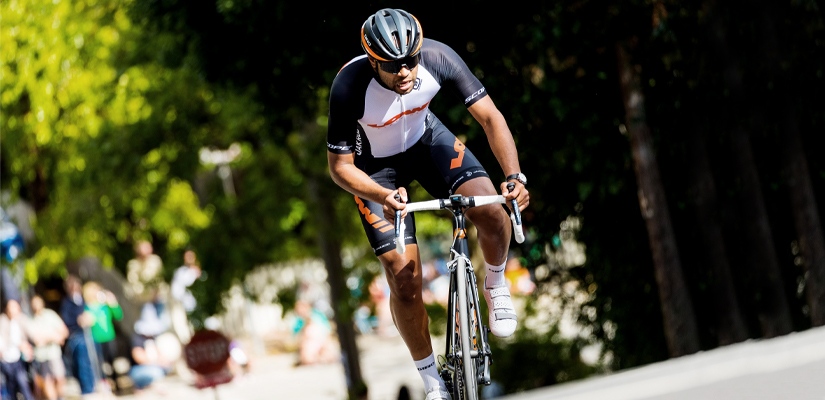Training With Strava Segments

When you don’t have events on the Calendar, attempting to get the fastest time on a Strava segment can be a fun and motivating training goal. As long as you can do it safely and in compliance with your local ordinances, here are some tips to help you grab that KOM or QOM.
For more training tips check out Ask a Cycling Coach Ep 253.
Strava Segments
Sharing rides on Strava gives athletes a chance to connect with friends, explore new routes, and share ride data with others. It also gives cyclists a chance to get a bit competitive with one another. Because, whenever you upload a ride, you’ll see how fast you were in comparison to everyone else who rode the same Strava segments.
A Strava segment is a section of a trail or road that has been marked as a segment in Strava. Based on the GPS data from your ride, the time you have on a segment will earn you a position on the leaderboard for that segment. The two fastest times on any given segment are earned by the fastest male and the fastest female. King of the Mountain (KOM) is awarded to the fastest male, and Queen of the Mountain (QOM) is awarded to the fastest female.
Chasing KOM’s and QOM’s
When you don’t have events on the Calendar, Strava segments are the perfect competitive outlet. Turning a segment into your own mini time trial is an easy way to put your fitness to the test, work on your mental fortitude, and compete with athletes in your area (from afar). They’re also easy to integrate into a training plan. With outside workouts, you can target segments that coincide with your intervals, or you can add C events to your Calendar when you want to take a dedicated Strava day.
If you don’t have any short term goals or events, create a Strava goal. This could be going after a KOM you’ve always had your eye on, getting a top ten time on a popular segment, or maybe ranking high on a longer segment.
If chasing KOM’s doesn’t personally motivate you, there are alternative ways to use Strava. You could aim for a personal record, the top spot on the leader-board of friends you follow or aiming to conquer a longer segment you’ve never done. Ultimately whatever goal motivates you most, that is the best fit.
Choosing a Segment
When you choose segments to target, try and find segments that reinforce your training and racing goals. The best segments will also parallel your strengths as an athlete or coincides with your discipline of racing.
For example, if you traditionally train for ultra-distance events, a longer segment or a route like segment would be a good goal. If short explosive power is your strength, maybe target a short punchy climb. If your strong suit is sustained power and you’d like to continue developing this ability a longer hill segment would be a good focus.
Analyze Your Power
If you aren’t sure what segments suit your abilities, take a look at your power PR chart on your TrainerRoad profile. Your power PR’s should give you a sense of your power in relation to time. For example, if you’re really crushing your twenty-minute power then a sustained climbing segment would be a good goal.
Consider the Variables
If you’re attempting to beat a time on a segment it’s important to consider variables like wind, trail conditions, road conditions, and traffic beforehand. Unlike a race where the course is roped off and every athlete is competing in the same conditions, the day you choose to ride will determine the conditions of that segment. A trail that’s fastest in the winter might be tough to tackle in the spring. Or a road that’s prone to a lot of wind might be tough to ride fast solo.
Prioritize Safety
Don’t chase segments that pose a risk to your safety. As athletes, we have a responsibility to stay as safe as possible when riding outside. If you’re an off-road athlete, avoid targeting segments with downhill sections and risky technical features. If you are training on the road avoid segments that have dangerous intersections or road conditions. Try and find segments that challenge your fitness opposed to your technical abilities.
It’s also important to consider the safety regulations in your area. If your local government has determined it unsafe to ride outdoors, follow these regulations. There are plenty of ways you can challenge yourself without going outdoors. Setting up a tough group workout with friends is a great way to practice social distancing while still testing your abilities.
Adding New Goals to Your Training
When you create a Strava goal you’ll need to evaluate the priority of this goal before integrating it into your training. If you still have races on the calendar that you’re training for then you shouldn’t adjust your training plan for a KOM attempt. Instead, add a ‘C event’ to your Calendar on the day you want to make a KOM attempt, or make it a part of an outside workout that coincides with the terrain of your segment.
If you aren’t racing this season or you don’t have events left on the Calendar, go ahead and add a designated ‘A/B event’ to your Calendar for your KOM attempt. If you use Plan Builder, changing your training plan is easy. Just add the event to your Calendar, choose the discipline that resembles your segment most, and Plan Builder will adjust your plan to accommodate for this new workout.
As long as you can do it safely and in compliance with your local ordinances, turning a Strava segment into a personal time trial is a fun competitive outlet.
For more cycling training knowledge, listen to the Ask a Cycling Coach — the only podcast dedicated to making you a faster cyclist. New episodes are released weekly.